Canoeing to Crull and Thompson Islands, ARIW, PA
April 02, 2009. I went canoeing for the second time in a week.
The goal of both trips was to visit the two uppermost islands of
the Allegheny River Island Wilderness in northern PA. This is
the countries smallest national wilderness. The first island is
Crull Island, 96 acres in size. The second is Thompson Island,
72 acres in size. Portions of each island had been farmed in the
past, but still they contained some extremely large trees in
what could be characterized as an old growth forest. A week ago
Carl Harting, myself, and Dale Luthringer put our canoes in a
Brokenstraw Creek for a short trip to the Allegheny River
itself. Dale had to schedule the trip a month in advance, and as
luck would have it, it was the worst day in weeks that found us
on the river. It was a light cold rain as we paddled down the
river.
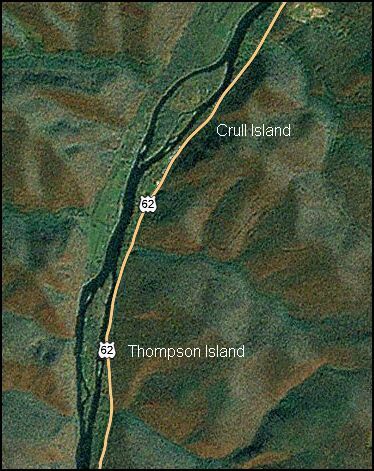
We put in at the top of Crull Island. The very top of the island
had been flooded recently.
Debris had been swept from the surface leaving a muddy
flat interspersed by some channels and pools.
Underlying the mud is a layer of harder coble sized rocks
deposited when the island was affected by the full flow of the
river, prior to the construction of the Kinzua dam a short
distance upstream.
The edges of these islands would be washed away and the
redeposited in the same area as the spring floods rose and fell.
The change of the flood regime will affect the long term
stability of the islands that have persisted for likely several
thousand years. It
already is affecting the flora growing on the islands.
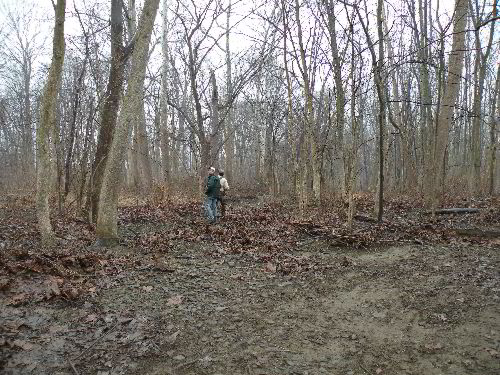
Upper end of Crull Island
One of the goals of this trip was to remeasure some large
hackberry trees first documented by Dale in 2004.
The tallest he found at that time was measured at 99 feet
tall, and we wanted to get a new measurement to see if we could
find a sprig over 100 feet.
Also on the earlier trip Dale had not been able to
explore the entire island, parts of the downstream end still
needed to be explored.
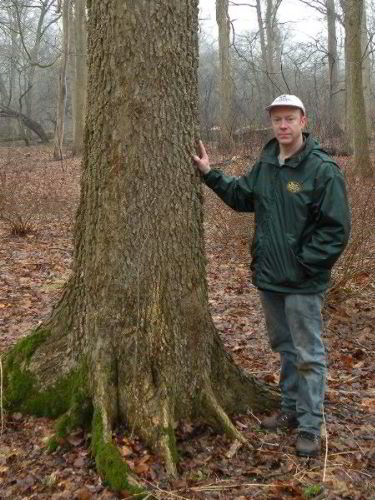
Carl Harting with Hackberry
We started to measure some magnificent trees.
There were American
Sycamores measured to a heights of over 130 feet.
Carl Harting found an exceptional white ash (Fraxinus
Americana) at 131 feet tall, by far the tallest found on any of
the islands. We
measured a variety of other species. I was impressed by the
jungle like quality of some hawthorn thickets on the island.
While Dale and Carl
hunted big trees I measured some of the miscellaneous species
found scattered about the island.
I measured a couple nice hawthorn trees the tallest was
38.9 feet.
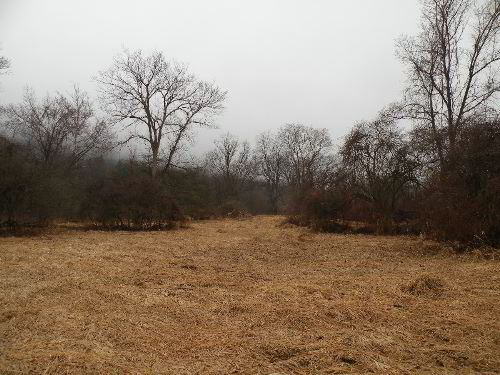
Field of reed canary grass,
Crull Island
In the central portion of the island was a large open area that
in the summer would have been a field of reed canary grass.
I am not sure if this was a natural open area or what had
once been a farm field now overgrown by this invasive.
In the midst of this field of canary grass are patches of
hawthorn and hawthorn is encroaching on the open area.
There is a dearth of other species present in these open
areas dominated by canary grass.
They are filling in around the edges behind the hawthorn.
Hawthorn seems to be the only pioneering species that is
capable of overgrowing the reed canary grass.

Dale Luthringer with thick grapevine
I added butternut, staghorn sumac, and some others.
In the midst of an impressive patch of hawthorns and a
couple apple trees there were fat grape vines.
One measured 1 3 in girth.
I managed to measure a nicely formed black cherry, 8 9
in girth and 75 feet tall with a thick fork about ten feet up.
Another interesting tree was a white ash 11 2 in girth
and 96+ feet tall.
The tree forked a dozen feet off the ground to make two equal
size trunks.
Between the two forks the lower trunk split all the way to the
ground. Looking in
the crack it appeared that the tree was a single trunk with the
break splitting the base vertically and not a double trunk tree.

White Pines on downstream
side of Crull Island
Near the far end of the island we found a pair of white pines.
In our explorations of all the other islands of the wilderness
area, these were the first white pines we found anywhere. It was
on the higher downstream end of the island above most of the
flood waters. While canoeing past Fuelhart Island, a privately
owned island in the river located among the islands of the
wilderness itself, a couple years ago we did see one white pine,
but did not stop on the private property to measure it.
We also found some white pine on another privately owned
high island Hemlock Island farther downstream. By this time,
after a brief let-up in the rain, it was raining harder than
ever. We could not use our instruments in the rain. It was
miserable, so we abandoned the rest of the trip and paddled
downstream to out take-out point across from Thompson Island.
Again as bad luck would have it, Carl and I swamped are canoe
just as we reached shore at the pullout an appropriate ending
for a rainy day.
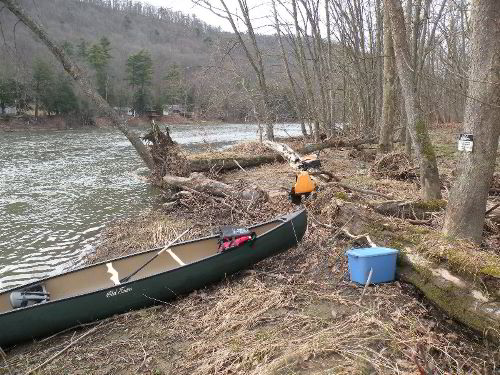
Crull Island landing
The second trip on April 2 went much better. It was just Dale
and I this time. Carl unfortunately could not make it.
Frost was on my windshield as I left in the morning. We
again out in at Brokenstraw Creek and paddled down the river,
this time in the morning sunlight. The first stop was again
Crull Island There
were a couple of loose ends we needed to finish, ad we also
needed to explore the downstream tip of the island.
On the first trip I had photographed a nice musclewood
(Carpinus caroliniana) but had not measured it.
The first order of business for me was to relocate that
tree. Once found we
looked for the tall white ash Carl had found on the previous
trip. I wanted to
take some photos and to confirm the height of it and some of the
tall sycamores.
Rain can play tricks on the rangefinder.
We found the trees and confirmed their heights.
Looking at the hawthorn trees in the reed canary grass field,
there were two distinct forms I could see.
If the branches had not been still bare, likely they
would have been indistinguishable.
I pointed this out to Dale, and after a bit he also
decided these might represent two different species of the tree.
At the Johnstown Flood Museum National memorial the
bio-inventory report lists six different species of hawthorn
growing in old fields.
I dont know who did the identification and how reliable
they are, but it is a curios tidbit that seems to fit here.
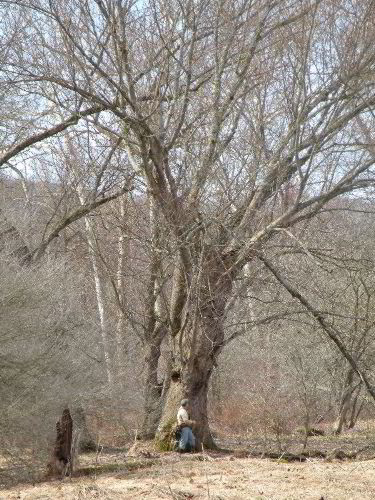
Sycamore, 15.8 foot girth, 76.7 feet tall
The going downstream along the left edge of the island we
explored some new territory we had not managed to visit on the
first trip because of rain.
This area was generally open with reed canary grass.
Silver maples grew along the river bank.
The tallest topped out at 110.8 feet. One fat silver
maple one had a girth of 15.8 feet, but was only 76.7 feet tall.
Once we reached the point Dale and I split up to explore
a bit more. I
started measuring hawthorns in a thicket along the right bank.
They were tall for the species, but I could not break 40
feet. Then pay
dirt! I found a
44.4 foot tall hawthorn.
From here I swung back up the island to where the pair of
white pines were located.
Absent the rain I was able to get a better height of 94.8
feet for the taller of the two trees.
Then it was back to the canoe.
I had hoped to find a yellow birch sighted on the first
trip in the pouring rain, but somehow missed it.
We had only found one other on Baker Island in our
explorations of the wilderness islands. There were many
waterfowl on and around the island, and three white-tail deer
scooted across the island as we explored.
From Crull Island we headed down to Thompson Island. An immature
bald eagle flew ahead of us as we paddled. We had explored the
upper portion of the island previously, but the lower third was
impassible due to a thick mass of Japanese knotweed, a nasty
invasive species, up to ten feet tall that formed a dense
thicket. After the winter the knotweed had died back and we
could see into the area and force our way through it. We managed
to measure a number of big sycamores and silver maples in the
midst of what had been the knotweed thicket.
Of particular note was a tall silver maple we measured at
128.9 feet. This makes it the tallest of its species known in
the Northeastern US.
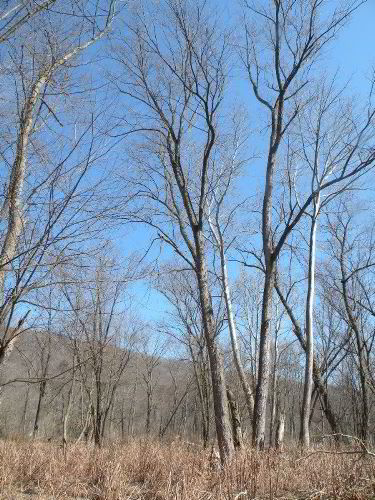
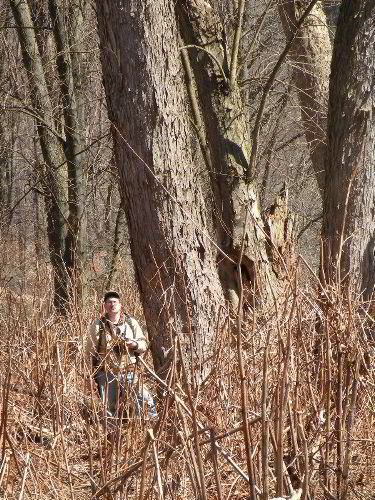
Silver maple champion, 128.9 feet tall, girth 10 feet
I also was able to photograph a massive seven trunk silver maple
at the lowest end of the island. We found it on a previous trip,
but the photos did not turn out well. The tree had a combined
girth of 24 feet and was 108 feet tall.

Multi-trunk silver maple
At the lower end of the island we found what appeared to be a
manmade channel cut into the edge of the island.
A cut square timber could be seen in the bottom of the
water course.
Perhaps this was a grist mill, or a sawmill at some time in the
past.

Alleopathy under a small hawthorn
We documented more tree species on this trip that we had not
measured before, including river birch and black willow. The
last things of note were the hawthorns.
Again we had two distinct forms of the tree here on
Thompson Island.
Underneath one of the smaller trees in the midst of the canary
grass was a darker patch of grass, smaller in size.
The thick mats of downed canary grass were absent.
This could be an example of chemical alleopathy on the
part of the hawthorns and could explain why they have been able
to colonize into the reed canary grass while other species have
not. The afternoon was
sunny and reached into the low 60s. About 5 pm we headed across
to the pullout. We were both a little sunburned and tired by
now, but it had been beautiful day on the river.
The only thing missing was Carl on this second trip

Moss Cypress
On the way back from Thompson Island we stopped at Buckaloons and measured the Moss Cypress growing
there.
Ed Frank
Crull Island
3/26/09, 4/2/09
Other species noted but
not measured = yellow birch, silky dogwood, raspberry,
blackberry
Species CBH
Height Comments
Am. basswood
7.4 104.4 re-measure from years back
Am.
basswood N/A 113 fused w/shagbark 6ft up
Am.
elm 8.9 98.2 called it a slippery
from years back, it IS an American, WAY 851 41 49.379N x 79
16.068W
Am.
hornbeam 3.3 29.5 Ed measure
apple
sp. 4 31.5 Ed measure
black
cherry 8 9" 75 Ed measure
bitternut hickory
7.5 N/A
bitternut hickory
8.3 82.9 Ed measure
bitternut hickory
6.6 100.8
black locust
2.6 59.3
black willow
2.4 24.4
butternut 6 4" 39.5 Ed measure, 58ft
crown
butternut 4.2 45.2
butternut 5.8 68.8
common hackberry
9.1 60.1+
common hackberry
10.2 78.1+
common hackberry
9.7 87.1
common hackberry
7.6 89.6
common hackberry
7.3 90.3
common hackberry
8.3 93.3
common hackberry
7.2 93.9 Carl measure
common hackberry
7.3 96.7 re-measure from years back
common hackberry
6.6 100.5 re-measure from years back, WAY 850 41
49.380N x 79 16.029W
E. white pine
10.4 94.8 Ed remeasure from April trip
green ash
6.3 96.4
hawthorn
3.2 N/A
hawthorn
3.5(2x?) 33.8 Ed measure
hawthorn 4
4" 36.3 Ed measure, 43ft crown
hawthorn 3
3" 38.6
hawthorn
3 38.9 Carl measure
hawthorn
2.9 44.4 Ed measure
N. red oak
11 4" 103.8 Ed measure
silver maple
12.7 N/A (from March trip)
silver
maple 12.7 99.1 Ed measure
silver maple
14.9 73.1 Carl measure
silver
maple 15.8 76.7 Ed measure
silver
maple 5.8 96.9
silver
maple 11.4 99.7 Ed measure
silver
maple 11.1 110.8 Ed measure
slippery elm
3.4 57.1
slippery elm
4 10" 100.8
staghorn
sumac 1.7" 22.5 Ed measure
staghorn
sumac 1.9 28 Ed measure
striped maple
3.5" 9 Ed measure
sugar maple
5.2 101.4 Carl measure
sugar maple
7.1 102.2
sugar
maple 8.9 111.1+ re-measure from years back
sycamore 10.3 105.9
sycamore
9 109.1
sycamore
6.8 114.6 Carl measure
sycamore
5.8 118.2
sycamore
8.1 119.5 Carl measure
sycamore
7.9 119.9 Ed measure
sycamore
10.4 120.9
sycamore
8.7 121.5
sycamore
8.4 125
sycamore
6.2 126.2 Carl measure
sycamore
13.5 126.3 re-measure from years back, WAY 854 41
49.378N x 79 16.092W
sycamore
8.3 126.8
sycamore
9.8 129.1
sycamore
11.8 132.3
sycamore 10 133.7 Carl measure
Vitus
sp. 1.3 Ed measure (March
trip)
Vitus
sp. 1.4 Ed measure (April
trip)
white
ash 11.2 96 Ed measure
white ash
8(6'up) 106.8
white
ash 6.8 107.4 Carl measure
white
ash 9.8 117.1+
white ash
10.8 131.7 Carl measure to 131, confirmed to 131.7
Thompson
Island 4/2/09
Other species found but
not measured = striped maple
Species CBH Height Comments
Am. beech
7.3 81.5 Ed measure
Am. hornbeam
2.9 30.9
Am. hornbeam
2.6 39.2 Ed measure
black willow
9.2 61 Ed measure
common hackberry 2
41.1
green ash
3.9 106.4
river
birch 1.9 22.2 Ed measure
silver maple
N/A 108.5
silver maple
10 117.4
silver maple
10 128.9 NE height record, WAY 856 41 47.416N x 79
17.122W, avg crown=67ft
sycamore 9.2 123.7
sycamore 6.9 126.9
sycamore
8 127.6
sycamore
9 129 Ed measure
sycamore
8.5 129.2
sycamore
7.9 130.4
sycamore
8.1 138.6
white ash
5.2 106.9
white ash
N/A 108.1
Anders Run
4/2/09
Buckaloons
4/2/09
Species
CBH Height Comments
moss cypress
N/A 86.4 re-measure from years back